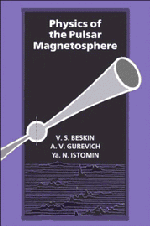Book contents
- Frontmatter
- Contents
- Introduction
- List of Notation
- Constants and Quantities
- 1 Basic observational characteristics of radio pulsars
- 2 Neutron stars
- 3 Physical processes in the pulsar magnetosphere
- 4 Electrodynamics of the pulsar magnetosphere
- 5 Generation of electron–positron plasma in the pulsar magnetosphere
- 6 Pulsar radio emission
- 7 Comparison of theory with observational data
- Conclusion
- Appendix
- References
- Additional literature
- Author index
- Subject index
6 - Pulsar radio emission
Published online by Cambridge University Press: 12 October 2009
- Frontmatter
- Contents
- Introduction
- List of Notation
- Constants and Quantities
- 1 Basic observational characteristics of radio pulsars
- 2 Neutron stars
- 3 Physical processes in the pulsar magnetosphere
- 4 Electrodynamics of the pulsar magnetosphere
- 5 Generation of electron–positron plasma in the pulsar magnetosphere
- 6 Pulsar radio emission
- 7 Comparison of theory with observational data
- Conclusion
- Appendix
- References
- Additional literature
- Author index
- Subject index
Summary
We have determined the properties of electron–positron plasma in the pulsar magnetosphere. It is generated in the polar cap region and moves along a curvilinear magnetic field at a velocity close to the velocity of light. Particles of this plasma must give curvature radiation whose basic characteristics – the frequency range (3.31) and the direction (3.32) – are close to the observed pulsar radio emission. However, the wavelength of curvature radiation (3.33) is much larger than the distance between particles in a plasma flux. In this case an important role is played by a collective interaction between the particles and the field. In other words, the radiation must be coherent (Ginzburg et al., 1969), i.e. must be a fundamental mode of plasma oscillations. To find and to describe quantitatively the radio emission generation mechanism, it is therefore necessary to investigate the excitation of natural high-frequency oscillations of a relativistic plasma flux moving in the polar region of a magnetosphere. This chapter is aimed at solving this problem.
In Section 6.1 we investigate the dielectric properties of a relativistic electron–positron plasma placed in a homogeneous magnetic field and find the fundamental modes of electromagnetic oscillations. In Section 6.2 we take into account the effect of magnetic field inhomogeneity, i.e. the curvature which determines mode instability. The non-linear stabilization and mode transformation effects are studied in Section 6.3.
Electrodynamics of relativistic electron–positron plasma in a homogeneous magnetic field
Dielectric permittivity of a homogeneous plasma
We shall consider a relativistic electron–positron plasma placed in a strong homogeneous magnetic field B.
- Type
- Chapter
- Information
- Physics of the Pulsar Magnetosphere , pp. 229 - 277Publisher: Cambridge University PressPrint publication year: 1993



